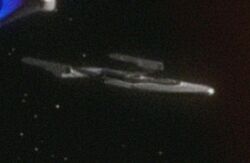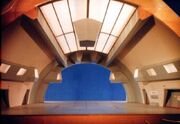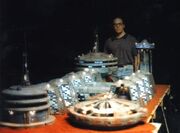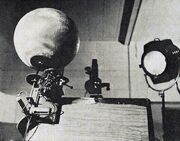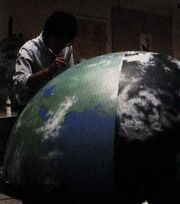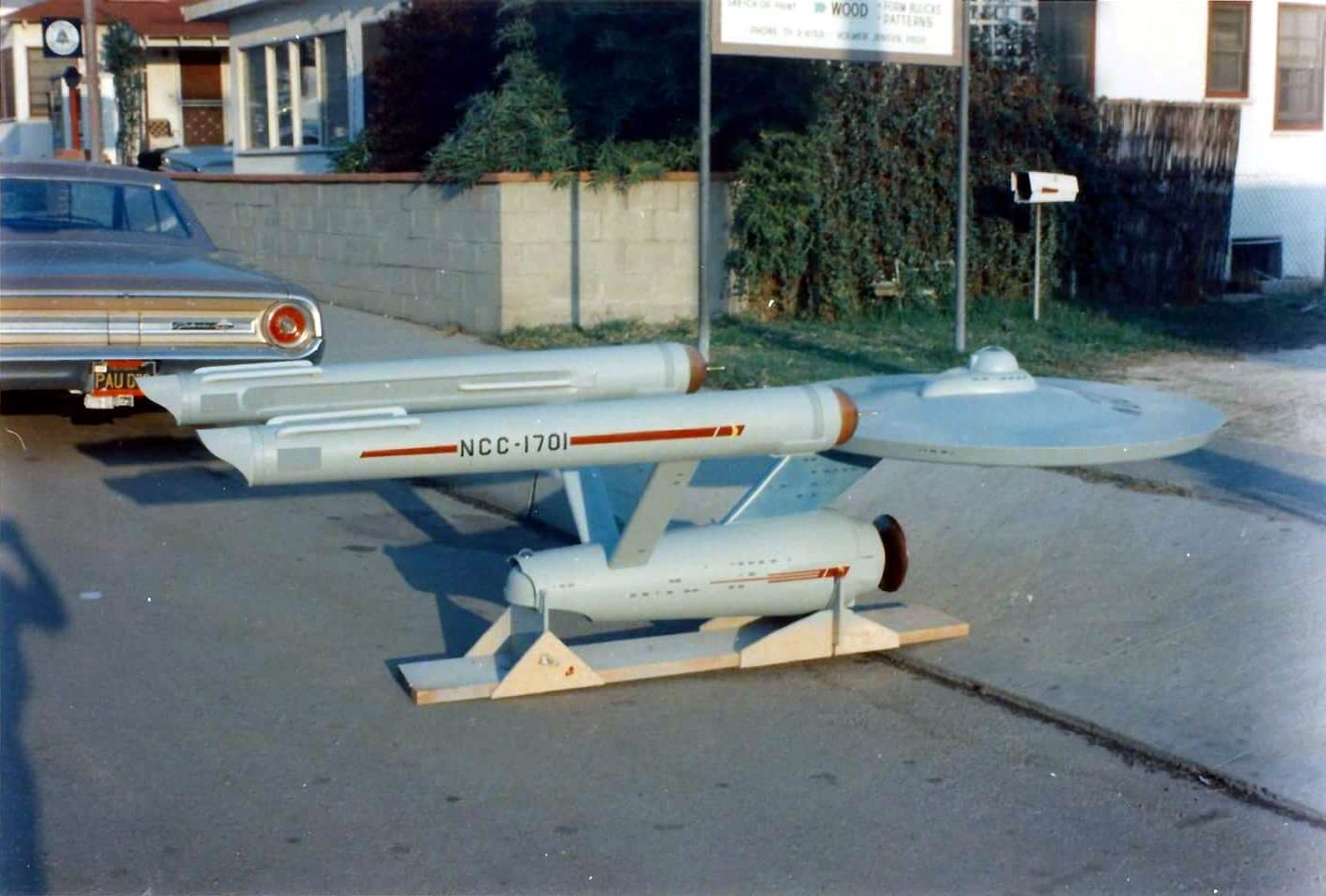
Occasionally if a miniature needed graphic retouching, VFX would arrange to have the teamsters pick the model up and bring it to the art department. That was always a big event, because the ships were our idea of celebrities. They, more than anything, seemed to embody what the show was all about...symbolic of Human aspiration and ingenuity.Doug Drexler
A studio model (or filming model, as it is also referred to) is a type of scale miniature used in the Star Trek live-action television series and Star Trek films to represent various (inanimate) objects, craft or ships. Strictly speaking, the term is applicable to all the types hereafter mentioned. As production asset, a studio model is currently understood to be a visual effects (VFX) element.
While the expression "studio model" has traditionally been used to refer to physical miniatures, as indicated by Drexler in his above quoted statement, the advent of Computer Generated Imaging (CGI for short) in the 1990s (most notably thanks to the science fiction series Babylon 5), meant that the definition as an VFX element had to be expanded to include digitally created CGI models, also referred to as "3D models", as well – those of the starships in particular.
| Studio models |
|---|
| The Original Series • The Animated Series • Films • The Next Generation • Deep Space Nine • Voyager • Enterprise • Discovery • Short Treks • Picard • Lower Decks • Prodigy • Strange New Worlds |
Filming model
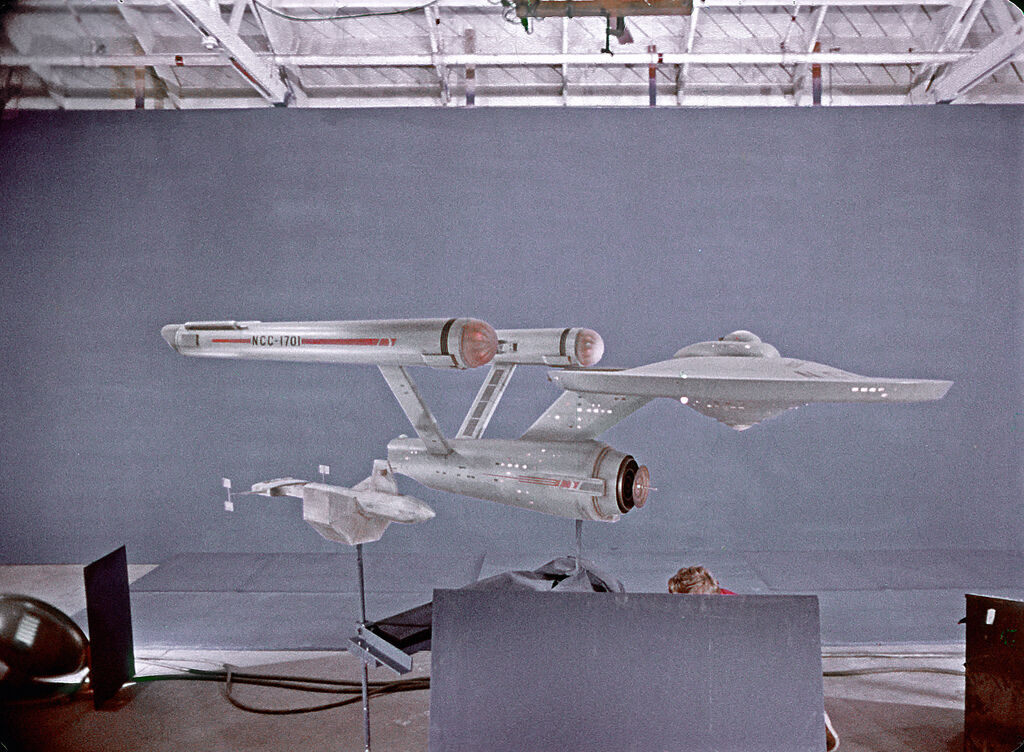
In practice, both expressions "studio model" and "filming model" (the latter of which is more applicable to this case) have been habitually reserved to indicate those miniatures that served as the primary models used for second-unit filming in productions. As far as repetitive productions were concerned, a further distinction was sometimes made in:
- "Hero" models – intended for regular use – represented the best miniatures, used for beauty shots and close angles. These were typically the largest, most detailed and best-made models.
- "Guest" models – intended for unique or irregular use – were often made more simply and cheaply. In many cases, they were repainted or modified for reuse as other objects in later episodes. These models, when they concerned starships, were sometimes referred to by visual effects staffers, among others Adam "Mojo" Lebowitz of Foundation Imaging, by the expression "Ship-of-the-Week". (Star Trek: The Magazine Volume 1, Issue 6, p. 51)
In some cases, footage of a model was reused as a stock element, and simply referred to as a different ship. Time and cost considerations were the primary reason for such reuse. According to model maker Gregory Jein (in an interview appearing in TNG Season 3 DVD-special features), the art, and visual effects departments typically had three to four weeks to design and create each model, during the run of a series – sometimes less time. It should be noted that on these occasions, detailing and finishing quality of the filming models would rarely have gotten the seal of approval of professional model makers of, for example, display models for museums. Professional modeler Jason Eaton, who restored the McKinley-type studio model for the auction winner of the model, has noted in this respect, "(…)it NEVER ceases to shock me how rough some of these models are, under close scrutiny. I know they're made under impossible deadlines, but man, some of those seam lines and bubbles in the castings made me cringe, when I left things untouched… you have to match what you're making to what exists!!" [1] The practical reason for this was that in the pre-High Definition television age, a high level of quality detailing would have taken up more time, and thus more money, and was not necessary anyway, as possible shortcomings would not have been discernible on-screen. Model and prop maker Ed Miarecki, formerly of Science Fiction Modelmaking Associates and Industrial Light & Magic (ILM), has even put it more crassly when he stated, "These models were never meant to last. They were only designed for one thing, then they become dumpster fodder." (FanAddicts!, Season 1, Episode 3: Star Trek) The build of a (hero) model during the pre-production stage of a television series (due to the larger amount of expected close-ups), or a model for a movie (due to the greater demands made of the model for big screen requirements), was a different story altogether, typically taking up considerably more time. The six-foot USS Enterprise-D model for example, took three months to build, discounting the design stage, whereas the movie Enterprise took a whopping 14 months to complete from start to finish. (The Making of Star Trek: The Motion Picture, p. 207)
The fleeting nature of studio models Miarecki referred to as "dumpster fodder", was in particular applicable to the Ship-of-the-Week models, especially those which were from the start intended to make an unique appearance as a deep background element only, most notably the below mentioned "kit-bash" models. This had practical and economical reasons as Production Illustrator Doug Drexler explained, "When you work on a television show for many years, especially one like Star Trek, and particularly at the time that we did, you end up with all kinds of stuff that would otherwise have been thrown away. I know a statement like that… "stuff that would have otherwise been thrown away"… usually starts a firestorm of criticism of the studio. You don't need to say that today [note: referring to CGI models]. Looky, you know what a geek I am about this stuff, yet I understand that the studio cannot save everything from all of their productions. Also remember that at the time, auctions where fans could own a piece of the show were non-existent. Storing stuff was not economically feasible. Sometimes just building a crate to store something costs more than the model did! Not to mention renting a place to keep it all. Star Trek at it's peak had huge storage north of LA. That adds up. Not everything could be saved. Thankfully, peeps like Gary couldn't bear to see stuff go into the crusher. So into personal storage it would go, and some of it not to see the light of day again for over twenty years." [2] Aside from Gary Hutzel, Drexler himself, VFX Supervisor Adam Buckner and VFX Producer Dan Curry were among those production staffers who habitually saved one-time use items after their production use, like these models, for their own collections, some of them to offer them up later at auction.
Building a physical filming model
There were basically two methods of building used in the movie industry of constructing filming miniatures and both have been used in the Star Trek franchise:
- Classical build-up method: This has been the most common way of building a studio model and has been used in the industry from its very inception, right up to the advent of CGI. Essentially, it is almost the same method as someone building a commercial model kit, starting from the inside, applying parts and details as one goes along. Traditionally, wood has been the material of choice and has been used well into the 1960s. Models could be made out of massive wood (such as the three-foot Enterprise and the D7-Class) or, if internal lighting was required, the wood was hollowed out (for instance, in the case of the secondary hull, bridge and nacelles of the eleven-foot Enterprise). New materials like plastics and fiberglass became available in the 1960s and 1970s and largely replaced wood as the premiere construction material, because they became cheaper, easier and faster to work with. Vacuum-formed parts typically were applied to an armature framework (needed for internal strength and often as a mounting point for filming), resulting in models that were lighter than if they were made out of wood. The saucer section of the eleven-foot Enterprise was the first piece constructed this way and the movie Enterprise was a complete build around an armature. Apart from producing custom-made vacuum-formed parts, parts from any and all commercially available model kits could also be applied to construct a studio model (for example, the long-range shuttle and the original Borg cube). This method of building resulted in a one-of-a-kind model and has been used to produce the models for TOS and the Star Trek films.
Vacuum forming is one of the oldest methods of molding organic polymers, with widespread use since the development of modern plastics. A negative mold is produced, in which heated plastic is poured. The air between the plastic and mold is sucked out to achieve a perfect fit. Once the plastic has cooled, the part, called a cast, is removed from the mold. Contrary to the model kit industry, which uses very expensive metal molds, model makers in the movie industry normally make their molds out of cheap, baked clay, since the part needed is often a one-off. An additional advantage is that details such as grid-lines can be inscribed before the mold is baked. The mold is often destroyed when the cast is removed from it.
- Master-Mold-Cast method: This method became viable when newer composite materials started to become economically available in the late 1970s, early 1980s – not without health risks, as several model makers would die from the then not understood chemical side-effects from working with these materials, as attested to by several colleagues in 2011 (Sense of Scale, disc 1). The first stage using this method was the production of a master, sometimes also referred to as a template or as a pattern. The master was a solid rudimentary (part of the) model, typically made out of Styrofoam, clay or a combination thereof. It was then used to produce a negative mold. Contrary to the molds normally used to produce vacuum-formed parts, this mold was made out of a flexible material, like silicone rubber. Into this mold, heated material such as acrylic plastic, resin or fiberglass was poured, resulting – after cooling off – in a positive cast. These cast were then assembled, often around an aluminum armature, into a complete model. At first glance, this seemed like a more elaborate method of building a studio model, but there were distinct advantages compared to the classical method of build-up.
- In some cases, detailing of the model could be sped up. Whereas detailing on a classical build-up could be time-consuming, detailing on a master could be quick and dirty, using everyday items like masking tape, pins, paper clips and such. If clay was used, details could be carved in. Either way, the details would be permanently imprinted onto the mold. In the case of the six-foot USS Enterprise-D model, which (together with the two-feet model) was among the first Star Trek models to be produced this way, a translucent material was used to produce the casts. The parts were painted and, where lighted windows were supposed to be, the paint was merely scraped away (or, if used, masking tape was removed after painting) to allow the internal lighting to shine through, a vastly time-saving method compared to drilling out holes, normally used up until then, when constructing a model the classic way.
- A major advantage of this method, which was more of an issue in television productions (due to its repetitive nature), was reproducibility. Since the molds were made out of a flexible material, they could be removed from the casts easily, and more importantly undamaged, and used over and over again. As the masters were usually too damaged after use they were normally discarded, but it was the molds that were to become the working capital of the model maker. They could be used to quickly produce copies and replacement parts to various ends. For example, the molds of the two-foot Enterprise-D and Enterprise-C were used to produce the Niagara-class and Freedom-class; the molds of the four-foot Enterprise-D were used to construct parts for the Nebula-class studio model, a break-away model for "Cause And Effect" and a limited, commercially available production-run of twelve for the Viacom Entertainment Store, as were the molds for the D'deridex class models, also serving for the construction of a second studio model. But it was Jein's original molds of the Star Trek: Phase II D7 class model that became particularly productive for the various D7, and K't'inga class models which made later appearances in Star Trek productions.
| Chronicle of a filming model build at ILM using the Master-Mold-Cast method | ||||
|---|---|---|---|---|
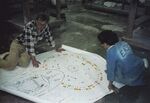 |
 |
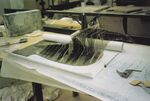 |
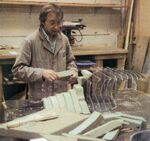 |
 |
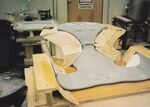 |
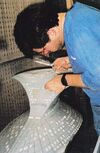 |
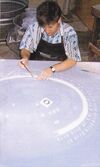 |
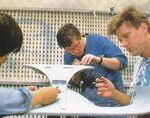 |
 |
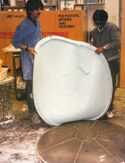 |
 |
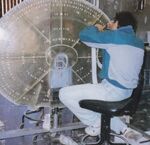 |
 |
 |
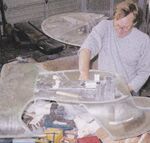 |
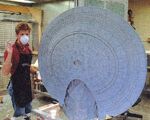 |
 |
 |
 |
| Galaxy-class USS Enterprise-1701-D | ||||
- The first known model-maker who employed an early variant of the method for the Star Trek franchise was Brick Price Movie Miniatures, in constructing the abandoned Phase II Enterprise model. Price retained the molds of the model when he was pulled from the project in 1978 and has used them since, to produce several display models for the Planet Hollywood restaurant franchise in the 1990s. This method of constructing a studio model has been the method of choice of Gregory Jein and Tony Meininger, and the vast majority of models for televised Star Trek (beginning with TNG) were constructed this way. It was possible to retro-apply the method to existing models, using them as master. Molds were taken from the original D7 model for Star Trek: Phase II and from the USS Grissom model to produce the SS Vico. However, there was a realistic chance to damage the original models (it is conceivable that the repaint performed on the D7 model in 1977 was done to repair damage when the mold was removed).
Costs of building a physical filming model
Usually, Hollywood production companies are loathe to publicly divulge details on costs of productions. While aggregates are often published, details such as specific costs of, for example, studio models are not. The Star Trek franchise therein is no exception. Yet, over the years, some figures of studio model construction costs have come to light and, as happenstance had it, of arguably the three most signature vessels of the franchise, coincidentally spanning a period of twenty years plus, providing some insight into the development of technique advancement and the differences between a model for television productions or feature productions.
| What does it cost to construct a physical filming model for Star Trek ? | ||||||||
|---|---|---|---|---|---|---|---|---|
| Model | Year of construction | Cost in dollars | 1965 adjusted[1] costs | 1978 adjusted costs | 1987 adjusted costs | 2006[2] adjusted costs |
2010 adjusted costs | Notes |
| USS Enterprise | 1964 – 1965 | >$6,600[3] | $6,600 | >$13,137 | >$23,375 | >$41,631 | >$46,125 | Total costs, incl. construction and modifications, for both the three-, and eleven foot models. |
| refit – USS Enterprise | 1978 – 1979 | $150,000[4] | $75,362 | $150,000 | $266,908 | $475,362 Sold for: $240,000 |
$521,616 | Unclear if the costs for the abandoned Phase II model are included.[5] |
| USS Enterprise-D | 1987 | $75,000[6] | $21,177 | $42,192 | $75,000 | $133,575 Sold for: $500,000 |
$146,572 | Aggregated costs for both the two- and six feet studio models |
- ↑ Dollar Times Inflation Calculator
- ↑ Year of the studio's assets sale in the 40 Years of Star Trek: The Collection auction
- ↑ Star Trek: Communicator issue 132, 2001, pp. 51, 53
- ↑ The Making of Star Trek: The Motion Picture, p. 207
- ↑ The reference book Star Trek Phase II: The Lost Series, p. 75, strongly indicated it to be the case; As far as the several sets in their various states of completion were concerned, this actually made business sense as they were, albeit with additional redesigns, yet used for The Motion Picture, whereas the Phase II studio models were all discarded.
- ↑ Star Trek: The Next Generation Companion, 3rd ed., p. 12
Traditionally, studios, those of he Star Trek franchise included, have habitually balked at the cost incurred by the construction of physical studio models, perceived as (too) high since it was labor intensive manual work. As repartee to this, Matthew Gratzner of Hunter/Gratzner Industries, responsible for the construction of break-away models for the Son'a collector model, decided upon at the eleventh hour, has dryly postulated, "I always say that visual effects are not expensive – it is the lack of decision making regarding visual effects that is expensive." (Cinefex, issue 77, p. 92) Grazner did have a point in his assessment, as the history of the Star Trek franchise is rife with examples of this, the construction, apart from Grazner's Son'a break-away models, of the eight-foot movie Enterprise model being a prime example.
Building a CGI filming model
In a remark, reminiscent of the one that Jein made in regard to physicals studio models, John Gross of Eden FX, stated that it took on average two- to four weeks to construct a new CGI studio model for an ongoing Star Trek television production. [3] For further information,
- See main article: Building a CGI model
Studio model types other than filming models
Aside from the filming models that were primarily used for the actual filming of a production, there were several other types of studio models in use in the industry, constructed on occasion to specific ends.
Study model
A study model or concept model, as it is also sometimes referred to, is behind-the-scenes nomenclature for a rough miniature built to study how a particular design might look in three dimensions and will normally lead up to the full-fledged studio models. Study models could be extremely crude, sometimes made of illustration or foam core board, or sometimes cobbled together from found objects, or sculpted from foam or other substances. Often crudely detailed, they were not meant to be used in actual productions, but to evaluate a design from all angles, before moving forward with or scrapping the design. However, they could be detailed enough for them to occasionally end up on camera when a need arose in a pinch of having them appear in the background of a shot where their limitations would not be apparent, such as the proto-Nebula-class and the various proto-Excelsiors. The earliest Star Trek study model, was the four-inch balsa wooden evaluation model of the Enterprise, Matt Jefferies constructed in 1964 for the NBC executives to mull over. (Star Trek: The Magazine Volume 1, Issue 10, p. 26)
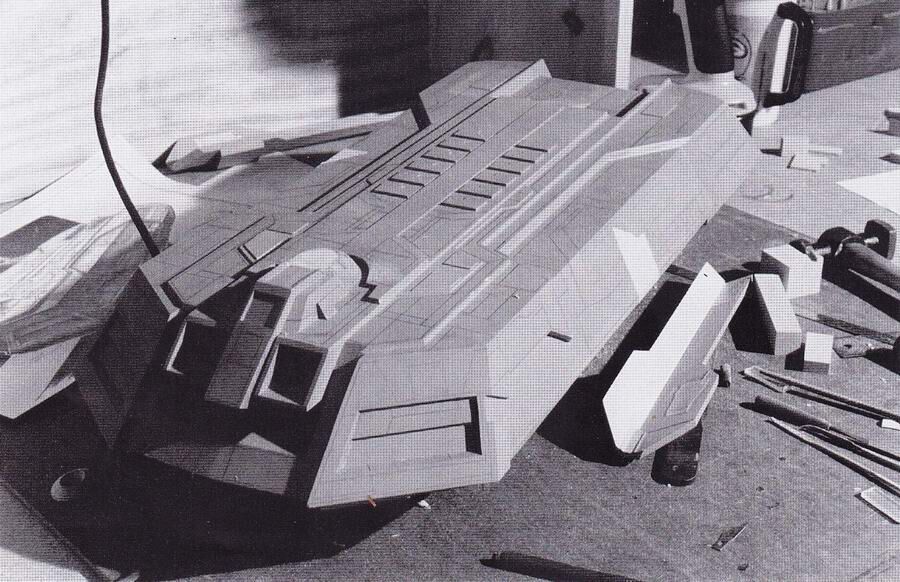
Even in the CGI age, study models are occasionally constructed as a visual aid for designers and programmers and/or as a scanning model for digitizing. Examples were the study model built for Star Trek: First Contact of the T'Plana-Hath and the Federation holoship model and Son'a collector for Star Trek: Insurrection. Daren Dochterman elaborated in this respect, "Physical models are often built even when the final product will be CG…in some cases, it's to show producers and others the item in question in a real world context because sometimes a picture on a screen just doesn't make an impact like a real life item does… and on other occasions, it's done to give an in-house model crew something to do to justify billing the production company for it… and to maintain its existence. I'm not saying that was the case here, as I really just don't know… but when I was on The Chronicles of Riddick, we had an in-house model crew led by the great Greg Jein building models of all the ships that we were designing for 3d… the impact of having them in real life was very inspiring for both the crew, and the studio head…" [4] Jim Key added, when he wrote up an article on the making of Insurrection, "I was equally comforted by another comment that both Jim Rygiel and Carlyle Livingston made to me–essentially how they both strive to have maquettes built for pre-visualization, and the importance of study models and/or scanning models. Though many times now the finished form may be in CG, these physical representations still serve their purpose when seeking approvals, since they hide nothing and reveal nook and cranny." (Sci-Fi & Fantasy Models, issue 34, p. 31) As to underscore Key's comment, it was only when the producers were presented with the scanning model of the "Federation Holoship", that a design flaw was detected.
Major filming models themselves can serve as scanning models for their digital counterparts as well, as had been the case for the Intrepid-, and Sovereign-class models.
Kit-bash
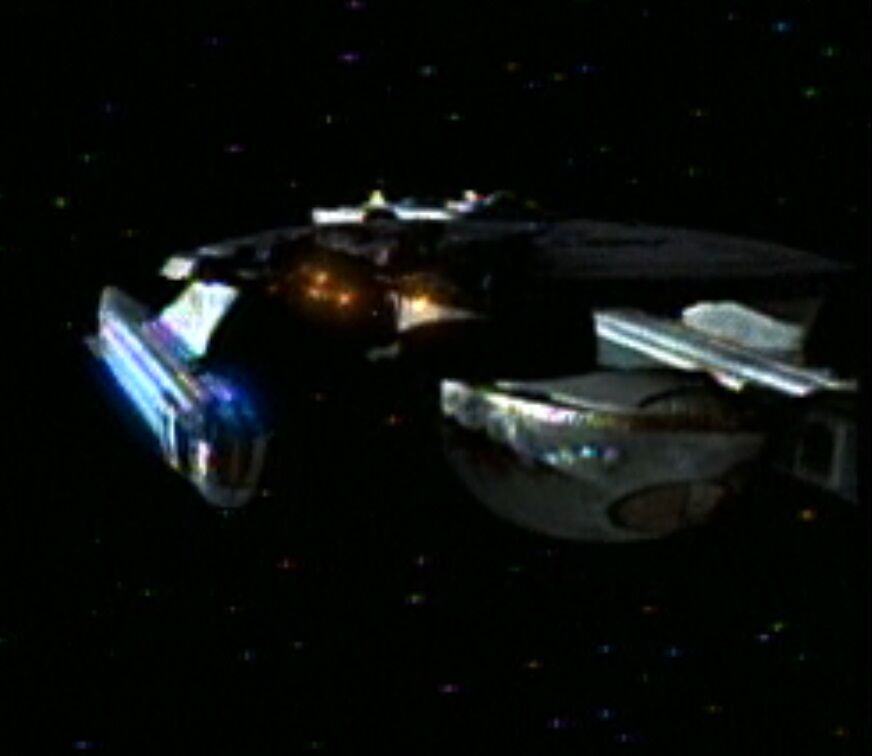
The term "kit-bash" is a behind-the-scenes term used to describe a ship, station, or any other model created by the production staff from already existing parts of other ships, station studio models, additional model kits (not necessarily Star Trek-related), and/or any and all items at hand during the time of building and deemed appropriate for application. On occasion the related term "kludge" was also used to designate such builds. Star Trek Scenic Artist Anthony Fredrickson was considered especially adept in the technique of kit-bashing by his colleagues, as they endowed him with the nickname "King of Kludge". [5](X) Kit-bashing has been a common method for creating filming models in the science fiction genre, such as in the movie Alien, in which they served as the hero models.
An early example of kit-bashing (or rather a modification, strictly speaking) in Star Trek is the Aurora in "The Way to Eden", which was the reuse of one of the two Tholian ship models previously featured in "The Tholian Web", complete with Constitution-class nacelles and D7-class pylons, those originating from their respective AMT Star Trek model kits (numbers S951 and S952). In later incarnations of Star Trek, however, kit-bash models served primarily as (deep) background elements, the method lending itself for quick and cheap assembly when additional elements were required in a very short time.
The vast majority of ships seen in the aftermath of Battle of Wolf 359, in The Next Generation's two-part episodes "The Best of Both Worlds, Part II", and at the Surplus Depot Z15 in "Unification I", were kit-bashes. Among the Federation classes shown there that are designated "kit-bashes" were the New Orleans-class, Springfield-class, Cheyenne-class and the proto-Nebula, using parts from various model kits, whereas the Freedom-class and Niagara-class were kit-bashed from parts derived from Gregory Jein, Inc.'s own, already existing, production assets. Several other kit-bashes were also built for several Deep Space Nine episodes, most notably "A Time to Stand" (including the Centaur-type, Curry-type and Yeager-type), again using parts from model kits.
Kit-bashing has also expanded to CGI. Examples of CGI kit-bashes were the Intrepid-type and Nebula-class, which were constructed out of existing parts of the CGI NX-class and CGI Galaxy-class, respectively. In addition to designs seen on screen, non-canon Star Trek games featured kit-bashed designs.
Breakaway model
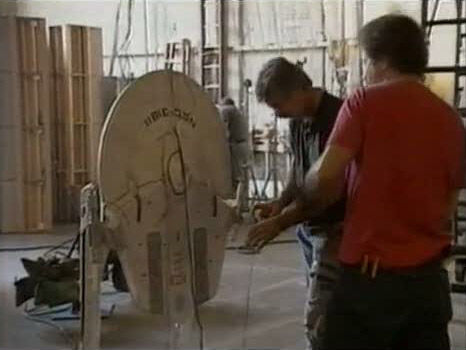
A breakaway model is a model specifically built for on-screen or in-camera destruction. Models of this kind were typically built for destruction scenes, when it was felt that a convincing destruction could not be achieved through various procedures in post-production, like matting stock footage of explosions over shots of studio models, and when it was deemed that the master models were too valuable for destruction. Normally built at a smaller scale with lighter materials and constructed in such a way through pre-scoring or pre-cutting, that debris would fly off easily, these models were packed with pyrotechnics to be detonated at the directors will. Normal procedure was that those models were suspended from the ceiling and that shots of them were taken by a high-speed camera directly underneath, to emulate normal dispersion of explosions, when the shot footage was played back at at lower frame rate. Typically, several models were made, in order to have the best shot possible. Break-away models for Star Trek included the Miranda-class (DS9: "Emissary"), the Galaxy-class ("Cause and Effect") and both versions of the Borg cube ("The Best of Both Worlds, Part II" and First Contact).
Advances in CGI have made breakaway models increasingly obsolete.
Camera test model
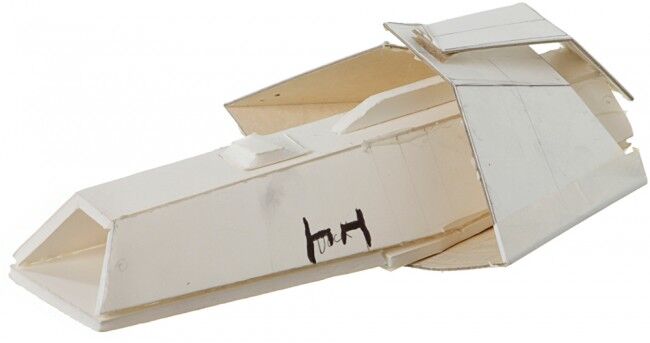
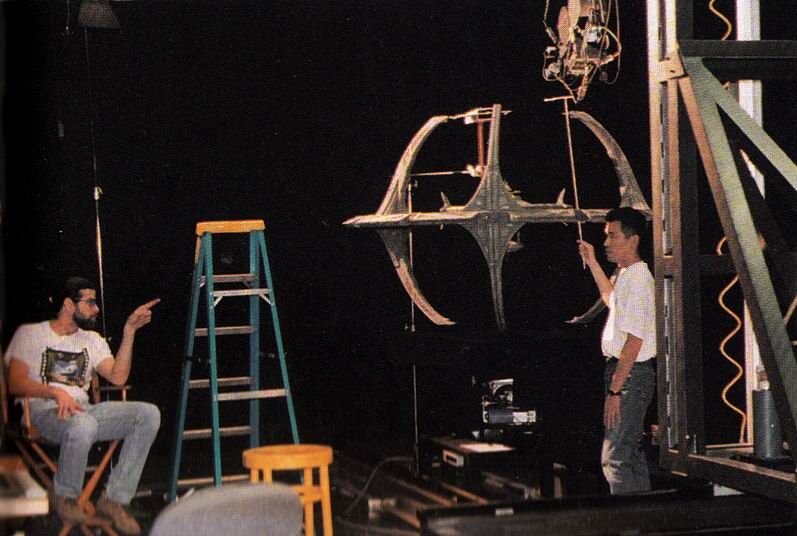
A camera test model, also known as a pre-visualization (pre-viz) model or massing model in the more recent digital age, is a model usually made out of cheap material like paper, cardboard, wood or Styrofoam in particular, loosely modeled after existing studio models. Detailing varied from very crude to moderate, since they were never intended to appear on-screen. They were typically used by VFX coordinators/supervisors and camera teams as visual aids to set up camera shots in pre-production planning before final shooting. Advantages using test models were that the production staff did not have to handle the usually heavier filming models, or as Doug Drexler once jokingly put it, "You only pulled out the big models once you pretty much knew what you needed" [6](X), and that wear and tear to those models was reduced. Most of the Star Trek filming models had one or more test model counterparts. Licensed, commercially available models and model kits were known to have fulfilled this role, as well. (Star Trek: Communicator issue 148, p. 48) Examples of these were the AMT Star Trek model kits of the Danube-class, two of which being sold at auction. [7](X) [8](X)
Too rudimentary to serve as filming models, camera test models have nevertheless been on at least one occasion used as such. Though the pre-visualization technique had already been firmly established by the time Glenn Neufeld was brought aboard the franchise as VFX supervisor during the latter half of Deep Space Nine's first season, it was Neufeld in particular who embraced the technique and it was he who took the very unusual step of using them as filming models when the production of the second season episode "Sanctuary" came up. The episode featured a huge fleet of Skrreean refugee ships arriving at Deep Space 9, and Neufeld realized there was no practical way to have each ship individually shot and edited in post-production. He recalled, "We had to to create all the ships they arrive in. The script read "There are more than ships at the station than we have ever seen before, a ship in every docking port and hundreds more lined up waiting to dock." As soon as you read something like that, you know you're in for a lot of late nights. We called in our foam fleet. We put them on C-stands, arranged them and shot them six to ten at a time. We'd made marks on the monitor to show where they were, then we'd rearrange them, move the camera further back to make them smaller and shoot them again. When we were finally finished we had this yellow brick road of ships going off in the distance." How unusual his approach was at the time, was realized by him when he got a call from post-production editing, "They told me the negative was covered in scratches, and I thought, my goodness, my shot's been ruined. It turned out to be the background ships. Some of them were so small that the people at the lab thought they were dirt." (Cinefantastique, Vol 25 #6/Vol 26 #1, p. 100)
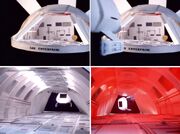 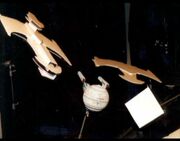 |
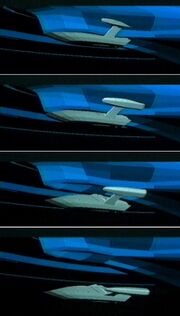 |
A very closely related use of these models, was their use in the so-called "animatics". Animatics was a behind-the-scenes term used to denominate short clippings of footage especially shot at the behest of directors and/or VFX supervisors for evaluation purposes. This footage was normally shot for ascertaining if storyboarded sequences, typically VFX scenes, came across on-screen as intended. As this footage was essentially only intended for evaluation purposes, VFX were stripped to their barest necessities, and as such physical models were only marginally required to approximate the appearances of their filming model counterparts in the final production. It was in this specific use that "pre-visualization model" – usually abbreviated to "pre-viz model" – has become the more commonly used terminology. The advent of CGI has not abolished the use of animatics, they being a too valuable tool for directors and supervisors. On the contrary, CGI has made it easier to employ the tool. The moment the bare essentials of a CGI model is assembled, i.e. the wire-frame model, "light" versions of the model were typically employed for these pre-evaluation purposes. "Light", as in light on RAM-memory computer requirements, in this respect typically meant basic versions of CGI models as later employed in productions, but without the heavy computer processor usage for detailed texturing, rendering, or lighting, often preliminary wire-frame models clad with a non-nondescript skin.
Not only a very useful aid for camera teams, directors, and VFX supervisors in the pre-CGI age, physical test models were also useful aids for post-production compositors of VFX shots. As physical filming models were very rarely built in scale to each other, test models were often quickly built in scale with the filming model of the week they were supposed to interact with. Footage was shot with these in-scale models relative to each other in pre-production evaluation filming. The footage was then handed over to the compositors as visual aid in compositing the final shots, by superimposing appropriately scaled footage of the corresponding studio model over the footage of the test model. The more commonly used Star Trek models had several variously scaled test model counterparts. With respect to whichever filming model they were supposed to interact with, test models were occasionally annotated with remarks such as "Scale to…" on the test models themselves, as was evidenced on several of the numerous test models that were sold in the 2006–2008 wave of Star Trek auctions.
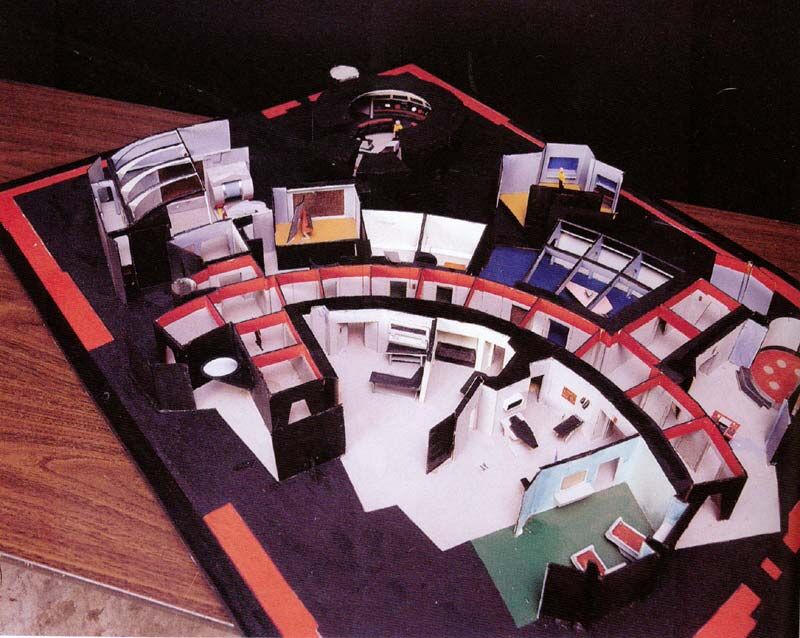
Several Styrofoam test models were also constructed of interior sets – prior to definitive, full-scale construction – throughout the run of the Star Trek franchise. Apart from being an aid in establishing camera angles, they were also an aid in evaluating a set design and, as such, in these cases, the functions of a test model and study model greatly overlapped. Examples of interior set test models were the models for the Excelsior-class bridge, [9](X) the interiors of Deep Space 9, [10](X) [11](X) stellar cartography, [12](X) and the Dauntless-class bridge, [13](X) among others. The oldest known such model was the (cardboard) pre-visualization model Matt Jefferies constructed in 1966 of the interiors sets for the original Enterprise as an orientation aid for directors and cameramen. (Star Trek: The Original Series Sketchbook, pp. 94-112)
With the advent of CGI, the physical test model did became a redundant aid.
Maquette
Occasionally used to refer to all other types of studio models, the French-derived term 'maquette' is usually reserved to signify scaled models of immobile structures, such as interiors and buildings, landscape miniatures or planet miniatures, intended specifically for on-screen use. As such, they are not to be confused with camera test models of interiors (not for on-screen use) and/or sets (full scale constructions for actors to interact with, in real time). Typically, they are constructed out of time and/or budgetary considerations or if an intended setting is deemed too imaginary to realize using existing sets or real life settings. While perhaps not being perceived as "glamorous" as their starship counterparts, and thus less publicized about, maquettes have been utilized throughout most of the run of the Star Trek franchise.
One of the earliest, if not the earliest, examples of such models used in the franchise was Richard C. Datin's model of the USS Enterprise's shuttlebay. He constructed this model in 1966, for the TOS episode "The Galileo Seven". Greg Jein repeated this in 1989 with the shuttlebay for the refit-configuration for use in Star Trek V: The Final Frontier.
As for buildings, generic futuristic-looking building models were often constructed to be positioned in front of a matte painting, to give the scene additional depth on-screen when filmed, as was the case in the Mars vista scene in VOY: "Lifesigns". Some of those models were featured in the TNG Season 2 DVD special feature: "Inside Starfleet Archives", and in it, it was discerned that they were usually built with whatever materials were on hand. Other examples were the models of Starfleet Headquarters (DS9: "Paradise Lost") and the building blown up in VOY: "The Killing Game, Part II". Though well into the CGI age, that building was built because, as Dan Curry explained, "When it comes to blowing up buildings, models still look far more convincing than CGI, simply because there's so many details to be included in such a sequence. This is why, for the Voyager Nazi episode, we built a 15-foot miniature building to blow up." (Star Trek: Communicator issue 148, p. 49) Numerous building models were sold during the 2006-2008 wave of Star Trek auctions.
Planet miniatures were a rarity within the Star Trek franchise as (full view) planets were traditionally executed either as matte paintings or, from the mid-1990s onward as CGI-effects. They have been used occasionally on The Original Series, most notably by the Westheimer Effects Company, (American Cinematographer, October 1967, p. 716) but rarely afterwards. Still, those rare instances involved ILM, who used physical studio models to represent celestial bodies, the Genesis Planet in Star Trek II: The Wrath of Khan, and the Moon and Earth (night and day view) models in Star Trek III: The Search for Spock being the prime examples.
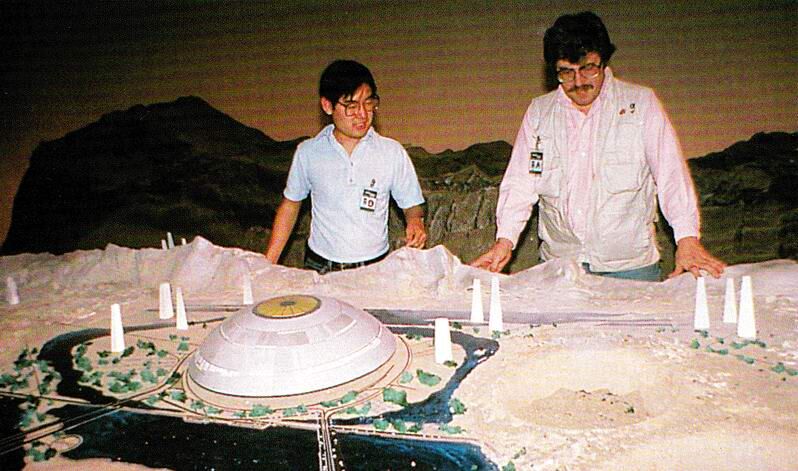
As far as landscape miniatures were concerned, they were also utilized in the Star Trek franchise. Though long views were usually executed as matte-painting effects, there were instances where the producers felt that the added three-dimensionality of a model could enhance an intended effect of depth perception. One of the earliest examples was the Deneb IV, or rather Farpoint Station, landscape model for TNG: "Encounter at Farpoint". This maquette was constructed by Greg Jein. Though he is usually associated with his starship studio model builds, landscape miniatures were actually a specialty of his. As a matter of fact, his work on a fairground maquette in the film 1941 won him a "Best Visual Effects Academy Award" nomination. Jein and his company also constructed the landscape miniature of the barren landscape Sisko experienced, after entering the Bajoran wormhole, in DS9: "The Emissary". (Movie Magic, "Models and Miniatures: A Model of Perfection" documentary) To come across believably on-screen, landscape miniatures and (for that matter) the other interior maquette types tend to be quite large, and due to their size, none of these are known to have survived, to date.
Curry's remark in the regard of "The Killing Game, Part II" maquette notwithstanding, by 2011, the maquette has been superseded by CGI, as far as television and movie productions are concerned.
Display models
Display models, or simply models, are scaled miniatures intended for on-screen use for actors to interact with. Typically, they were most commonly employed as adornments of sets where first unit filming with actors took place. While strictly speaking they confirm to the definition of "studio models", as set dressings, these models were in practice treated and considered as props and therefore understood to be a special effects element. Nevertheless, actual filming models as well as study models are known to have fulfilled the role of set dressing such as the Class F shuttlecraft studio model, the three-foot Enterprise model, the Epsilon IX station models and the proto-Nebula-class. However, the by far most utilized display models originated from commercially available model kits, the products from AMT/ERTL in particular.
An especially noteworthy category of display models were the reference models Greg Jein built, originally intended for representation in the Star Trek Encyclopedia and Star Trek Chronology reference books. Never meant to function as filming models, as they were only intended to fill in gaps in Star Trek lore to represent ships that were otherwise not seen on-screen in the franchise, and therefore not outfitted with internal lighting, some of these nevertheless showed up on-screen as display models. Examples of these were the Daedalus-class model, DY-100-class display model and the Bonaventure (C1-21) model.
On very rare occasions, such as the Malcorian warp ship or Jonathan Archer's remote controlled model spaceship, a design was conceived to be a model in the first place. Yet, on at least one occasion, in the case of the Constellation-class model, while the design started out as a display model, it eventually spawned a full-fledged filming model.
Demise of the physical studio model
As touched upon in the previous sections, the craft of physical studio model building has been increasingly relegated to the fringes in the motion picture business, due to versatility, increased sophistication, and the cost effectiveness of CGI. For the Star Trek franchise, the years 1997 to 1998 (during which DS9 Season 6, VOY Season 4 and Star Trek: Insurrection were produced) marked the completion of the full transition from physical studio model building to CGI studio model building. In 2004, Senior Illustrator and Designer Doug Drexler summarized, "Having been one of the poor slobs once covered with paint and glue, there is a wonderfulness to actually seeing something that you have created right there in front of you. But it's ultimately not worth it. Physical models fall apart, age poorly and their surfaces are not infinitely and nearly instantly adjustable. To look realistic, they need to be enormous and therefore unwieldly. Their lighting systems break down and are not easily repaired, their electrical systems can short out and often create interference messing up motion control equipment; seriously, the list goes on and on. Finally, miniatures just can't match CGI for visual quality. Even the expensive and gigantic Enterprise-E model had problems; in First Contact, I could make out tooling marks on the hull. Meanwhile, in many shots of the large Enterprise-D model, you can see the bumps in the paint." (Star Trek: Communicator issue 148, p. 51)
While there is no denying the arguments stated by Drexler, Star Trek visual effects staff members, born and bred with the traditional methods, have met the introduction of the new technology with mixed feelings, as numerous production staffers have commented upon, some of them expressing their own motivations:
- Dan Curry (Visual Effects Producer) in 1996:
"It will come to be one of the dominant ways to achieve visual effects in the future. But I feel that the days of the miniature are not completely gone. There are some people, at least in our generation of filmmakers, who are more comfortable with miniatures. Just the fact that they're really there, you can light them, and there's a certain reality about them, forces CGI to be very, very careful to be like that. One of the observations I have about CGI is that the people who do it well, do it really well, but a lot of people who work in that field have backgrounds in mathematics and computers, and not necessarily in photography and fine arts. They may not have the [best] relationship with how things really look, which comes from standing out in a field and painting a landscape. One of the best ways of understanding light is by spending time looking at it […] For me, the future would be a matter of speed. For us, who have worked with these ships, we can get right up to it and say, 'I'd like to see it from right here.' When you work with CGI, because you start off with wireframes, there's a lot more compromises in the exactness of angles and what's going on with the lighting than there is in a miniature, simply because you can see it here. It's not quite the same. But I think CGI will become probably the dominant technique of creating visual effects. I don't know what year that will be, but it certainly looks it's going to go that way." (Star Trek: The Next Generation USS Enterprise NCC-1701-D Blueprints, booklet, pp. 14-15)
- Greg Jein (Model Maker) in 1996:
"Photography didn't kill art, like portrait painting or illustration; and similarly, I'm sure there will always be a need for models. Right now there are some things that CGI can't do, but given enough time and money, they will accomplish, say, explosions, and things like that. It's a question Dave Allen and I were talking about. Stop-motion animators are running out of business, too. That has happened very fast, but I'm more into the tactile thing, so I'd rather be playing with goo than punching a keyboard. It's amazing, some of the stuff that came out this past year. My God, If they go the way they've been going, then CGI will become both economical and a mainstay of television production, especially. In feature production they still have a way to go. As far as miniatures are concerned, I'll remain optimistic for the time being." (Star Trek: The Next Generation USS Enterprise NCC-1701-D Blueprints, booklet, pp. 14-15)
- David Merriman, Jr. (Model Maker) in 1996:
"Now, as CGI (Computer Generated Imagery) matures as a viable alternative to effects model shots, I would be surprised if I got any future work. Not because the model building jobs in the industry aren't out there. It's just that I'm not that hungry for them anymore. I've had my fling, and today ask too much money for my work. I like CGI! CGI will become the agent of a situation that I have long hoped to see come about: the elimination of actors! Specifically, politically active actors: all too often assuming the airs of royalty and spoilt children. I look to the day when the word "Hollywood Celebrity" will describe pimple-faced computer geek wearing a pocket-protector, seated in front of a Silicon Graphics display, digitizing scantily clad Jane Fonda look-alikes. CGI is good!" (Sci-Fi & Fantasy Models, issue 30, 1998, p. 42)
- John Grower (Visual Effects Supervisor) in 1999:
"The whole nature of doing the ships in CG was something that really hadn't been done before up close… That took up a lot of development. I think we pushed it as far as we could in the amount of time we had [remark: for Star Trek: Insurrection], and were pretty successful. I think it hearkens a new age, in that the next time we do it it'll be even better. We're just now starting to evolve towards being able to mix and match CG and miniatures (…) obviously miniatures have their place and will be used, but just knowing that you can do the CG just opens up a lot of creative freedom." (Star Trek: Communicator issue 121, p. 58)
- Rick Sternbach (Senior Illustrator/Technical Consultant) in 1999:
"Certainly for television CGI is very cost effective, and for many effects in features, CGI can accomplish what models cannot. I would think that miniatures will likely be around for some time, since even the latest USS Enterprise NCC-1701-E for First Contact was a ten-foot long model build by ILM, and extensive use of miniatures highlighted the miniseries From the Earth to the Moon. Cost considerations and visual effects aside, there is something immensely satisfying in seeing one's five-view drawings come to life as a real, three-dimensional object to ogle at and admire the workmanship, and to point to all the neat fiddly bits and wonder, "Hmmm… what if I put a Type XI phaser emitter over here and that'll leave room for a quantum microtorpedo launcher over there…"." (Sci-Fi & Fantasy Models, issue 36, April 1999, p. 34)
- Alex Jaeger (Visual Effects Art Director) in 2004:
"When you build a practical model, you have reality working for you. You don't have to worry whether it is going to look real or not, because it will as long as you put enough details on it." (Star Trek: Communicator issue 148, p. 51)
- John Eaves (Senior Illustrator) in 2004:
"There is a place for both. CGI takes all the hard edges off and blends the VFX elements together flawlessly. But models still have a look and weight that CGI doesn't […] Models will always have a place in my heart." (Star Trek: Communicator issue 148, p. 51)
- Doug Drexler (Production Illustrator) in 2009:
"Many people say they can always spot a CG model…that's except when they didn't! And they don't know they didn't! I guarantee that plenty of stuff has passed right by…usually real world stuff, because you aren't expecting it. I love physical models too, but CGI is better, not because it is easier (…and who says it's easier? You couldn't prove it by my life!) but because of how much more we can get out of it. The truth is that you could never detail a miniature as finely as a CG model. Maybe once upon a time, but not any more. We can fly a squadron of fully detailed vipers, with complete cockpit… animations playing on their monitors, characters in spacesuits flying them, with right into the fully detailed flight pod of the hugely gigantic BSG model, where there are people walking around… vehicles driving… and everything is fully lit, self and otherwise. Never happen in the physical miniature realm. (…) How many of the far out aliens in the new Trek film are makeup? There was a day, not long ago, when it all would have been makeup. I think miniatures will still be around for at least the next two decades, but their use will continue to dwindle. The same thing is going to happen to set construction, but to a lesser degree. same with stunt work. Eventually the audience will be computer generated as well… only kidding. But this is true: We did a pilot for a show where half the sets were virtual, and you wouldn't know." [14](X)
- Paul Olsen (Model Painter) in 2012:
"I was surprised that more than a few people asked about models and wished the films would drop CGI for models and build proper models... quite a number of people who made it a point that they liked CGI for effects, but would prefer seeing something ‘real’ when it came to models. Are you listening, Paramount? Richard, Jim, we might work together again yet!" (Star Trek: Creating the Enterprise, p. 88)
- Ronald B. Moore (Visual Effects Supervisor) in 2012:
"One thing about a physical model is that it shows wear. Every time you use it there is a little less shine or a little more damage. We would try to keep them in good shape but they got handled a lot. A computer model is just the opposite. It seems like the models get worked on continuously. A little change here, a little improvement there. Perhaps we want to get really close to a section in shot? That area gets improved. For the most part every time you use the model it gets a little better." (Flying Starships, pp. 33-34)
The hopes of the production staffers that physical models would somehow remain in a niche capacity notwithstanding, by 2010, the craft had all but disappeared from the motion picture and television industry for filming purposes, though it has remained in existence for the fabrication of display models for institutions such as museums, corporations, defense contractors, and even for motion picture productions when the need for one is perceived. In regard to the latter, and as if to underscore the sentiment of some of the above quoted production staffers, it was ILM that did reintroduce them – after a near two-decades-long absence in major movie productions – in the 2015 seventh movie installment of the Star Wars franchise, The Force Awakens, in order to achieve exactly that; the "feel" of physical studio models which had made the original first 1977 movie installment so memorable. [15] Having broken nearly every record in the book, The Force Awakens has more than validated the hunch and subsequent decision of the producers to go significantly "old-school", alongside the on par significant use of CGI. The Star Wars franchise continued using physical filming models, alongside CGI in their first live-action television series, the equally successful The Mandalorian, launched in 2019. (Disney Gallery: The Mandalorian: "Practical")
As it turned out, the allure of the on-screen tactile model feel was such that The Force Awakens Director/Producer J.J. Abrams – a fan of the original Star Wars trilogy and inspired by the physical model use on Star Trek: The Motion Picture – had already seriously considered the use of physical models for his prior project, the 2009 movie Star Trek, the one that relaunched the Star Trek franchise in the alternate reality. However, practical production considerations, made Abrams realize that going "old-school" would amount to a "vanity choice", as he had put it. (Star Trek: The Official Starships Collection, issue SP14, p. 11)
Even an as recent production as Seth MacFarlane's The Next Generation-inspired science fiction series The Orville (2017-) fell back on the near obsolete technique when it was decided go "old school" with a traditional physical studio model for the establishing shots of the "hero ship" Orville to get the retro feel McFarlane was aiming for. In order to achieve this, pilot episode Director Jon Favreau had to contract several veterans still versed in the antiquated technique which included Star Trek alumnus and veteran Robert Legato for the motion-control photography. Even though the majority of the other visual effects shots were executed as CGI, the footage taken of the physical model served as a library of stock footage (especially for the show's intro), apart from the model being used as as a scanning model as well as a camera test model, [16] just like ILM would do two years later for The Mandalorian, in their case courtesy John Knoll, who was responsible for both the build and filming of its hero ship, the Razor Crest. (Disney Gallery: The Mandalorian: "Practical") The creation of a stock footage library had actually already been Legato's original intent to begin with for the two original physical Galaxy-class models for The Next Generation back in 1987. (Star Trek: The Next Generation Companion, 3rd ed., p. 31)
Still, the sudden onslaught of CGI from 1993 onward caught quite a few (traditional) visual effects houses with heavy physical studio model emphasis unawares. While ILM was a pioneering company in the new technique and thus making the transition gracefully, Image G, for example, nearly folded, but managed to cope with the transition eventually, with another well-known effects house of the time, Boss Film Studios, being caught off guard and forced to close its doors.
Appendices
Further reading
- Industrial Light & Magic: The Art of Special Effects, Chapter 3: "Model Construction", pp. 41-63, 1986
- "The Making of the Cardassian Warship", Ed Miarecki, Sci-Fi & Fantasy Models, issue 16, December 1996, pp. 24-27
- "So, you want to build effects miniatures?! Part One", David Merriman, Jr., Sci-Fi & Fantasy Models, issue 29, 1998, pp. 51-55
- "So, you want to build effects miniatures?! Part Two", David Merriman, Jr., Sci-Fi & Fantasy Models, issue 30, 1998, pp. 36-41
- "Enterprise '64, The real Builders of the Storied Starship", William S. McCullars, Star Trek: Communicator issue 132, 2001, pp. 48-55
- "Enterprise '64, Part 2, Building a better Starship", William S. McCullars, Star Trek: Communicator issue 133, 2001, pp. 44-51
- Flying Starships, Chapter 4: "Flying Starships", pp. 29-41, 2012
Documentaries and specials
- Star Trek III: The Search for Spock (Special Edition) DVD special feature, "Space Docks and Birds of Prey"
- VOY Season 1 DVD special feature, Red Alert: Visual Effects Season One
- Movie Magic, Season 1, Episode 11, "Models and Miniatures: A Model of Perfection" (1995)
- Sense of Scale (2012)
- The Trek Not Taken (2013)
- FanAddicts!, Season 1, Episode 3, "Star Trek" (2013)
See also
- Model, the in-universe definition of a model
- Star Trek model kits
- Star Trek starship miniatures
- AMT, a manufacturer of Star Trek-based model kits that ended up being used in Star Trek productions
- Polar Lights, another Star Trek-based model kit producer
- List of studio model/prop designers and builders

